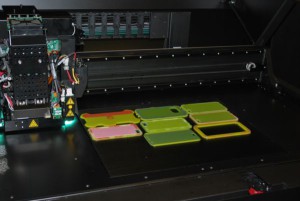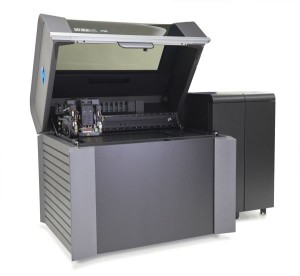Today we can, with the new 3D J750 printer by Stratasys
 The American producer of mobile phone covers OtterBox was the first testimonial of the presentation to the international press and to the market of the new 3D J750 printer by Stratasys. This new machine can produce polychromatic multi-material prototypes and objects in a single printing run. Thanks to its versatility, J750 produces prototypes, instruments, moulds, templates and equipment for assembling and much more, permitting product development players to take immediate decisions, thus significantly transforming the way of designing and releasing products on the market.
The American producer of mobile phone covers OtterBox was the first testimonial of the presentation to the international press and to the market of the new 3D J750 printer by Stratasys. This new machine can produce polychromatic multi-material prototypes and objects in a single printing run. Thanks to its versatility, J750 produces prototypes, instruments, moulds, templates and equipment for assembling and much more, permitting product development players to take immediate decisions, thus significantly transforming the way of designing and releasing products on the market.
Stratasys J750 is the new-born of the series of multi-colour, multi-material Objet Connex 3D printers, which allows choosing among over 360,000 different shades of colours and materials with a broad range of properties: from the stiffest to flexible, opaque and transparent ones. Prototypes can include a broad range of colours, materials and properties in the same item, speeding up the production of realistic models, prototypes and objects, actually for all applicative requirements. Besides, J750 grants a leaner workflow with the brand-new PolyJet Studio, the development software coupled with the machine that allows choosing with simplicity materials, optimizing the manufacturing and managing print queues. The machine idle times needed for the material change have been minimized, too.
Thanks to its capacity of managing a good 6 types of different materials, J750 allows keeping the most common resins constantly loaded and ready to print. State-of-the-art printing heads allow simulating productions plastics like Digital ABS, which now can be 3D-printed in half time compared to the printing with other PolyJet systems by Stratasys. Since the models printed in 3D leave the machine complete, with all wished colours, shades and materials, no time is lost for colouring and assembling. The definition/resolution in details and the finishing of J750 are important as well: 14 micron/1800 dpi of resolution.
OtterBox was one of the first companies that used the new Stratasys J750 and it was willing to witness the system efficacy. “We have been using the 3D printing for years now, but we have never seen anything so effective for our concept and development process as Stratasys J750”, stated Brycen Smith, technical-engineering supervisor of OtterBox. “Stratasys allows us to innovate in ways that we never thought possible and enables us to create identical prototypes to the product that we are designing, drastically reducing the times we needed in the past for the release on the market. The possibility of simulating elastomers and silicones thanks to particular acrylic resins made available by J750 allows us to make almost real assessments of the impermeable covers for mobile phones that represent the current core product of OtterBox. Stratasys J750 is a product that will transform the work modality both at OtterBox and in the entire 3D printing industry”.
 Thanks to the presence of six cartridges that manage as many materials in the production area of J750 it is possible to simulate whatever item, from the typical dashboards in the automotive industry to sports footwear and anatomic models. They are forefront photopolymer materials developed and produced in Israeli, in Stratasys headquarters. The real “revolution” consists in the elimination of the complex traditional processes that needed much more time and resources to create prototypes resembling the final product. Designers and engineers can experiment physically real prototypes manufactured in few hours with J750, starting from the initial concept to proceed then to the engineering and final validation. The decisions concerning the project can be taken immediately and under full safety, thus speeding up the product release times on the market.
Thanks to the presence of six cartridges that manage as many materials in the production area of J750 it is possible to simulate whatever item, from the typical dashboards in the automotive industry to sports footwear and anatomic models. They are forefront photopolymer materials developed and produced in Israeli, in Stratasys headquarters. The real “revolution” consists in the elimination of the complex traditional processes that needed much more time and resources to create prototypes resembling the final product. Designers and engineers can experiment physically real prototypes manufactured in few hours with J750, starting from the initial concept to proceed then to the engineering and final validation. The decisions concerning the project can be taken immediately and under full safety, thus speeding up the product release times on the market.
More and more versatile
In OtterBox headquarters at Fort Collins, after the opening of the press conference with the customary greetings by Arita Mattsoff, vice-president Public & Industry Analyst Relations & CSR of Stratasys, Joshua Claman, Chief Business Officer of Stratasys, briefly illustrated the development course accomplished by Stratasys on the market, then focusing on how 3D printing technologies have remodelled the product development concept, bringing some important witnesses as well. The bicycle producer Trek uses Stratasys technology to prototype full bike parts, Adam Opel has attained significant cost reductions in the implementation of mould inserts while Airbus uses Stratasys 3D printing to produce components to be used directly on some aircrafts.
“With the introduction of J750 we are reaping the fruits of 25 years of experience to lay a new milestone in the 3D printing field, thus reaffirming our commitment to keeping our customers always in the innovation forefront”, added Josh Claman. “With its immediate realism, J750 will simply disrupt the present procedures. Combining all colours with several materials and a lean workflow, this printer will recalibrate the 3D printing impact on the product development cycle. It will be possible to take informed design decisions shortly after the concept phase. The time saved by eliminating coIouring and assembling processes will result in shorter product release times on the market. J750 is a multitasking system able to produce also inserts for production moulds, moulds, training aids and other models, strongly enhancing the 3D printing versatility.”
Among the several organizations and companies able to benefit from J750, there can be consumer good manufacturers, service offices, design schools, schools, universities and research institutes, medical device producers, hospitals, medical schools and service companies for entertainment, such as animation and special effects.


